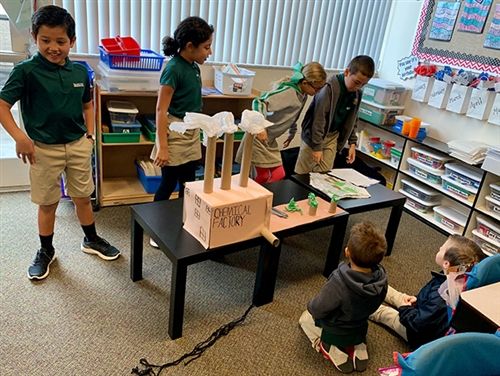

Third Grade Wetlands Project Share
Source/Author: Jennifer Hobbs, Third Grade Teacher
December 19, 2018
Third grade spent the beginning of the year learning, observing and creating projects about ecosystems. The curriculum was centered around the following essential questions:
- How do humans have an impact on the diversity and stability of ecosystems?
- How can change in one part of an ecosystem affect change in other parts of the ecosystem?
- What effect does the sun’s energy have on producers, consumers and decomposers within an ecosystem?
- How are organisms in an ecosystem interconnected?
Field Excursion
They started simply by taking a nature walk around the Shorecrest campus. The children observed the many living and nonliving things around school and made inferences about how they interact and depend on one another. They found a little world right outside the classroom doors with shrubs, grasshoppers, bees, moths, decomposing plant matter, and a black racer snake. They also took advantage of the pond along the back property line that demonstrates some aquatic life. They discovered two bat houses and witnessed an eagle gathering material for a nest.
The children took notes, sketched, and took pictures using iPad cameras along the way. They created posters with the pictures they took using Comic life.
Ecosystem Representations
After discussing what they already knew about ecosystems, students developed personal initial representations of these understandings, which led to opportunities for discussion and exploration to establish a foundation on the topic. This gave students the opportunity throughout the study for classes to think back to their original understandings and how they differed as they learned more about how organisms in an ecosystem are interconnected.
Next, third graders did some reading and research to create posters for a gallery walk, teaching each other key ideas about living and nonliving things, protecting ecosystems and food webs - and they all imagined that they were particles of energy traveling from the tiniest organisms to the largest predators.
Native Classroom
Mrs. Jeakle's eighth grade classes led a nature walk to view bald eaglets, osprey nests, and Shorecrest’s Native Classroom. The eighth graders, who were each paired with a third grader, were truly experts, and students scribbled notes on clipboards, eager to remember every detail. The children learned all about invasive and native species, how to tell the difference in the three kinds of roots of mangrove trees, and how to recognize the difference in the various palm trees. They learned about the projects that the eighth graders do to help preserve ecosystems on and off campus.
The tour ended with students uprooting some of the invasive Australian pines that threaten the biodiversity on the campus. The children enjoyed the adventure and were eager to share what they had learned with their classmates.
Bird Walk
Did you know Mr. Murphy is an avid Birdwatcher? The next part of the ecosystem study was a bird walk with Mr. Murphy. He made everyone aware of the many birds that live in and around the Shorecrest environment. With handmade binoculars in hand and keen ears, students set out in search of eagles, ducks, mockingbirds, osprey, hawks, cardinals and yellow crowned herons. They returned to the Native Classroom to try and get an owl to come out of its safe house, saw on osprey working on building a new nest and had a very special sighting of a yellow crowned heron. By the end of the tour, the children were able to identify the sounds of the birds as well as spot them as they flew from nest to nest.
Owl Pellets
Students next learned about environmental producers, consumers, and decomposers, getting their hands dirty in the process. First they watched an informative video on owls with a focus on barn owls. They learned about some of the unique features of an owl. Did you know that an owl can turn its head 270 degrees around and that it has fixed eyes? They also learned about what owls eat and how much an owl family of five consumes in a year.
Afterwards, the hands-on portion of the lesson began. They were enthralled to dissect owl pellets. Teachers modeled how to begin dissecting an owl pellet by using tweezers and a wooden pick. The students quickly got over the "yuck factor" of dissecting an owl hairball and were excited to find skeletons, skulls, talons and leg bones of rodents, shrews, birds and even moles in their pellets. In the process, they learned about primary and secondary consumers, owl adaptations, and food webs. The conversations were great as the children were trying to figure out what type of animal the owl had eaten.
Reading
Students were given articles to read related to their ecosystem study. They learned more about food chains and webs, different ecosystems, invasive species and problems in our environment that affect our ecosystems such as oil spills and climate change. Next, small groups received cards of several animals in a habitat. They were to decide which were predators and which were prey and create a food chain/web that would demonstrate understanding of how many things in an environment/habitat are interconnected.
Field Excursion to a Preserve
Third graders traveled to Boyd Hill Nature Preserve. The children got to see tons of things. There were gators and snakes and snails and even a deer! They learned how to watch out for poison ivy. The children were able to learn about different types of ecosystems such as marsh, wetlands, and uplands.
Pulling Invasives at Crescent Lake
If you were to interview the children to find out their favorite part of the study, most would be sure to tell you about riding in the canoes at Crescent Lake. As part of a community service project, the children learned about invasive species. Water Lettuce has become a big problem at the lake taking over some of our native plants. The children worked with Keep Pinellas Beautiful and Friends of Crescent Lake to hop in canoes and pull the Water Lettuce out of the lake.
Project Share
Finally, students created representations of what they learned from their ecosystem study. Family and friends were invited to see, hear and share.
Visitors could tell that students had learned:
- Organisms and their environments are interconnected
- Changes in one part of the system will affect other parts of the system
- Humans can alter the living and non-living factors within an ecosystem, thereby creating changes to the overall system
- Matter needed to sustain life is continually recycled among and between organisms and the environment
























